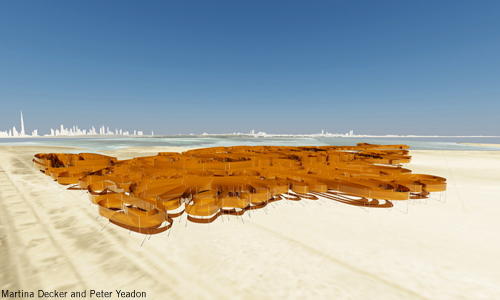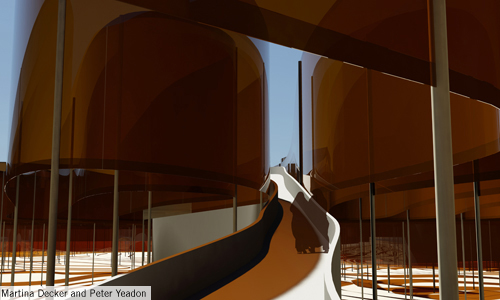By Martina Decker and Peter Yeadon (Decker Yeadon LLC, New York City).
Designed for Site #1 in Dubai, adjacent to Ras Al Khor Wildlife Sanctuary.

Design Submission for the 2010 Land Art Generator Initiative Design Competition
Artist’s descriptive text:
Light Sanctuary : An empowered landscape for the UAE
What if a mirage were real? The precise optical effects of reflection, diffusion, and inversion that are an essential feature of the desert landscape have acquired a reputation of mystery and even of deception. This proposal, instead, brings clarity, utility, lightness, and authentic meaning to the idea of the mirage: of a scintillating fluid structure seeming to float above the dry landscape, balancing and enhancing its calligraphic geography and fierce beauty.
To do this, we propose not the collection or distribution of water (the conventional illusion suggested by the desert’s optical effects), but instead the production of electrical energy. The project is a sea of ribbons, incorporating photovoltaic technology, touching lightly on the land, reaching out toward the water’s edge at the Ras Al Khor site. Forty kilometers of ribbons, some 80,000 square meters in total surface area, are raised like a continuous flag or banner, a minimum of six meters above grade. These ribbons, each 10m in height, are poised on a distributed network of strong but slender masts, structurally recalling the historical inheritance of fabric and nomadic architecture.
The ribbons are folded and swooped and nestled and caressed into complex waveforms that evoke natural landscape formations of desert and coastline, sand and water — but which are actually technologically optimized for the oriented exposure of their surface to light, heat, and shade. Their surfaces are continuous laminations of third-generation photovoltaics, an innovative ecological alternative to conventional silicon panels. This elegant thin-film technology has an inherent beauty: the surprising amber and pomegranate tones of its translucent surface evoke the resins, silica, and clays that are part of the desert’s natural botanical and geological resources.
This dye-sensitized solar cell technology exploits the light-absorbing properties of the organic dyes that provide its rich color. Within the thin laminations of the flexible membrane, an organic dye derived from botanicals like pokeberries and other plants enables solar energy to incite a titanium dioxide electron exchange, thus producing direct current that is harvested by transparent polymer electrodes.
Mature thin-film solar technologies are already available from various manufacturers (including Konarka, G24 Innovation, and others), and are well suited to this project and the requirements of its unique environment. Unlike older silicon-based panels, these translucent membranes can absorb light across 140º relative to their surface. This extraordinarily wide angle of available light absorption enables them to work well when installed vertically, which minimizes the accumulation of dust and sand; further, their flexible properties enhance their ability to vibrate small particles off the photovoltaic surface — to essentially be self-cleaning.
Although they are visually subtle, dye-sensitized solar cells are remarkably durable and stable in a wide range of climate and weather conditions, including extreme heat and extreme temperature change. Whereas the efficiency of older silicon-based solar panels falls as temperatures rise, the proposed organic dye technology becomes increasingly efficient with increases in temperature. A number of variables, such as reflected light from the desert floor and local atmospheric factors, will influence the operational generation of energy. Calibrated optimally, the ribbon array as proposed would generate 4592 megawatt hours (16530 gigajoules) of energy annually — an educationally visible expression of a contribution to the invisible electricity grid, and a comprehensible percentage of power production within the United Arab Emirates.
While it is informed by globally cutting-edge technology, this intervention is closely sensitive to the local presence, geology and living landscape of its setting. The entire land art installation floats as a sinuous gesture across 40 hectares, a little over half of the available Ras Al Khor site. The geometry and tectonics of the structure minimizes its ecological impact, yet optimizes its technological efficiency. Other than a carefully calibrated network of narrow supports, it touches the ground only at one concentration point in its waveform pattern, leaving the local desert surface, plant and animal habitats, and surface water flows essentially undisturbed and unimpeded.
The large surface area of the ribbons gathers abundant solar energy and directs its power toward this concentration point, protected and expressed as a single strong sculptural structure, which houses inverters and transformers, and also serves as the plinth for a raised viewing platform. This elliptical platform is approached by a ramped and curving path that guides the viewer up through a shaded forest of supports, up through a sea of amber, and up to a promenade just above the ribbons. From the adjacent Route 44 Highway and landscapes, Light Sanctuary has all the mystery and promise of a mirage at its most beautiful and powerful; from the ramp, one experiences a unique and contemplative visual immersion; from the viewing promenade, the visitor authentically perceives the modern reality and energetic potential to be seen in the city skyline of Dubai.



Related Posts
3 Comments
This site uses Akismet to reduce spam. Learn how your comment data is processed.

[…] by Lindsey Doermann Featuring Windstalk by Darío Núñez-Ameni and Thomas Siegl (Atelier dna), Light Sanctuary by Martina Decker and Peter Yeadon (Decker Yeadon LLC), and FERN by Takuya Onishi […]
[…] that is 40 kilometers long and features integrated dye-sensitized solar cells. The design, entitled Light Generator : An Empowered Landscape for the United Arab Emirates, was created by Martina Decker and Peter Yeadon, in response to the call for a large public art […]
[…] The very first competition submission to appear on the Land Art Generator website is a stunning, 40km flexible photovoltaic ribbon that features integrated dye-sensitized solar cells. Calibrated optimally, the third-generation solar cells would generate 4592 megawatt hours (16530 gigajoules) of energy annually. More […]